

Music Tech Teacher, Music Quizzes, Games and Worksheets. Music Quizzes, Games, Worksheets and Music Theory by Ms.
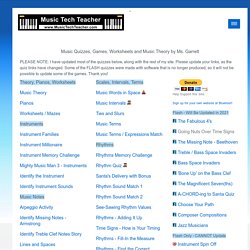
Garrett Scroll down the page to play elementary and middle school level quizzes, puzzles and games about music notes, rhythms, instruments, composers, and more. PLEASE NOTE: I have already updated 60 of the quizzes below, along with the rest of my site. Please update your links, as many of the quiz links have changed. Some of the FLASH quizzes were made with software that is no longer produced, so it will not be possible to update those games for mobile devices. Sign up for your own website at Bluehost! Help Support this Site... My jewelry site BeadsByKarenG.com The Music Tech Teacher website is a non-profit, personal educational site. Programs used to create the Quizzes: Articulate Storyline, Construct 3, Javascript, Hot Potatoes Adobe Flash Pro (Most will be converted to HTML5) 15 Free Music Activities and Lesson Plans for the Classroom. « Musical Penpals for your class | Home | Flashcards for the music classroom – expanded » The web is a great place to find free music activities and lesson plans that can be used in the classroom.

Here are 15 sites that provide helpful materials for teachers. Music - Interactive Sites for Smartboard Use – Grades K - 5 - Oak Street Elementary School - Plattsburgh City School District. MUSIC LESSON PLANS - Lesson Plans for music teachers. Classic Kids Songs. Music is a perfect match to learning and what better way to learn than to sing a song.
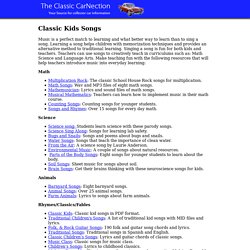
Learning a song helps children with memorization techniques and provides an alternative method to traditional learning. Singing a song is fun for both kids and teachers. Teachers can use songs to creatively teach in curriculums such as: Math Science and Language Arts. Songs & Poems. Seasons Special Days Animals.
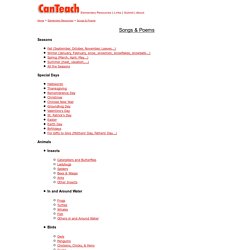
PBS Teachers . Thematic Teaching . Music in Every Classroom . Activity Ideas. Elementary School Lesson Plans for Music Subjects. Recognizing Patterns in Music and Children’s Literature Recognizing Patterns in Music and Children’s LiteratureMusic Education Lesson Plan Recognizing Patterns in Music and Children’s Literature Lesson Plan, Level: K-2 Lesson Plan Materials Required:• Whiteboard or chalkboard• Recognizing Patterns in Music and Children’s Literature Lesson Plan Pictures and Worksheet Handout ( … Subjects: Art, Language Arts, Music Grades: Using rhythm instruments with a story!
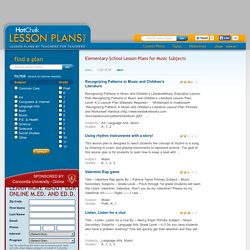
This lesson plan is designed to teach students the concept of rhythm in a song, by listening to music and playing instruments to represent actions. Popular Music Lesson Plans (Grades K, 1, 2, 3, 4, & 5) Elementary Music Lesson Plans. Music - Musical Elements Teaching Ideas. Soft Toys and Rhythm - A set of ideas for using soft toys to help develop rhythm.
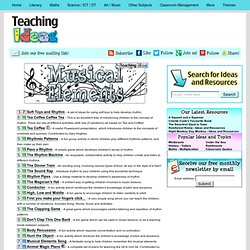
Tea Coffee Coffee Tea - This is an excellent way of introducing children to the concept of rhythm. There are lots of different activities (with lots of variations) all based on Tea and Coffee! Tea Coffee - A useful Powerpoint presentation, which introduces children to the concepts of crotchets and quavers. Contributed by Gary Hughes. Rhythmic Patterns - A fun group activity in which children play different rhythmic patterns, and then make up their own. Evans.pdf. Perspectives: Journal of the Early Childhood Music and Movement Association.
1_Brain-Friendly_Classroom_Music.pdf. Songs for Classroom Transitions. English as a Second Language. Arts Across the Curriculum, Grades K-5. Arts Across the Curriculum, Grades 9-12. Arts Across the Curriculum, Grades 6-8. 5 Resources for Integrating Music Across the Curriculum. Why Should I Use Music in My Classroom?
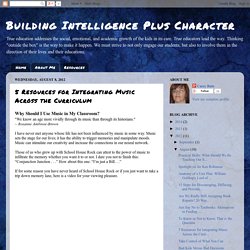
"We know an age more vividly through its music than through its historians. " ~ Rosanne Ambrose-Brown I have never met anyone whose life has not been influenced by music in some way. Music sets the stage for our lives; it has the ability to trigger memories and manipulate moods. Music can stimulate our creativity and increase the connections in our neural network. Those of us who grew up with School House Rock can attest to the power of music to infiltrate the memory whether you want it to or not. If for some reason you have never heard of School House Rock or if you just want to take a trip down memory lane, here is a video for your viewing pleasure. The truth is, using music in the classroom can impact student learning in a number of ways.
Ingenious Music & Math Activities! When you get to the site you will see a menu that includes: *Math and Science - Phil takes popular math manipulatives and enhances them with rhythm and music.
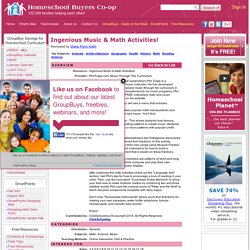
You'll find: -Unifix Cube Drum Machine - This shows students how famous composers have used repeating patterns to create music. Students can make their own rhythm or drum patterns with popular Unifix cubes. -Musical Fraction Bars - Mathematicians like Pythagoras discovered that musical pitches are derived from fractions. -Pattern Block Rock - Song melodies are patterns of short and long sounds. After exploring the math activities check out the "Language Arts" section. Music-math Integrated Activities for Elementary and Middle School Students: Song A. An and Mary M. Capraro: 9780981996608: Amazon.com: Books. Count the Beat. Can music-making help your pupils understand mathematical concepts such as fractions, ratios and probability?
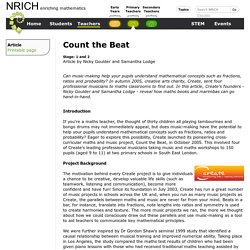
In autumn 2005, creative arts charity, Create, sent four professional musicians to maths classrooms to find out. In this article, Create's founders - Nicky Goulder and Samantha Lodge - reveal how maths books and marimbas can go hand-in-hand. Introduction If you're a maths teacher, the thought of thirty children all playing tambourines and bongo drums may not immediately appeal, but does music-making have the potential to help your pupils understand mathematical concepts such as fractions, ratios and probability?
Eager to explore this possibility, Create launched its pioneering cross-curricular maths and music project, Count the Beat, in October 2005. Project Background The motivation behind every Create project is to give individuals a chance to be creative, develop valuable life skills (such as teamwork, listening and communication), become more confident and have fun! Summing Up. Periods, Pitches and Pipes: a new middle-school teaching module connecting music and math. Megan Martinez and Alex Barnett, with help from Ilene Kanoff Despite the recent appearance of some good books on the connections between music and mathematics, there are very few teaching activities available that bring this exciting material into the high-school math curriculum.
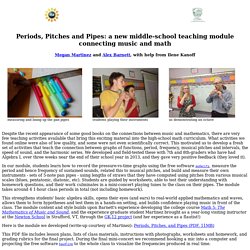
What activities we found online were also of low quality, and some were not even scientifically correct. This motivated us to develop a fresh set of activities that teach the connection between graphs of functions, period, frequency, musical pitches and intervals, the speed of sound, and the harmonic series. Connect With Music: Lessons Any Teacher Can Teach!
Teachers: Math in Music ~ Activities : Get The Math. Www.sedl.org/pubs/classroom-compass/cc_v4n2.pdf. Music Together. Music Education Lesson Plans - Music and Math. 3 benefits of music on early math skills. In early childhood education, the benefits of music include boosts to skills as varied as vocabulary development, gross-motor skills, empathy, phonemic awareness, active listening, and even early math development. Music and movement activities for three year olds (or toddlers or four,- five-, and older!) Look like fun and games, but behind all the laughter and smiles is learning. Consider these examples of the many benefits of music on children. Mathematics in Music (Lesson Plans & Printables) Highlights 2016 Presidential Elections Election day (Tuesday, November 8) is almost here! Help your students understand the process of our national elections, from the President down to local representatives, with our election activities.
Read short biographies of presidential candidates Hillary Rodham Clinton (D) and Donald Trump (R), explore mock election ideas, create presidential trading cards, learn election vocabulary, play election bingo and more! Thanksgiving Happy Thanksgiving! Encourage students to reflect on all they're thankful for this November 24 . Www.naeyc.org/files/yc/file/201201/Geist_Patterns_of_Music_Jan012.pdf. 5015846.pdf. Mathematics and Music at zZounds. Few people understand how mathematics is connected to music.
Music has to do with scales and notes. Mathematics has to do with numbers and symbols. How are they connected? The Math in Music & Movement. How can you connect music and movement to math? By incorporating musical activities throughout your day, you can provide children with opportunities to strengthen basic math skills. Think about the skills involved in singing a song such as "This Old Man". This simple song incorporates many basic math skills, including matching and comparing (through changes in pitch, volume, and rhythm); patterning and sequencing (through repetitions of melodies, rhythms, and lyrics); and counting and addition (identifying cardinal numbers and adding one more with each verse).
When you add moving to the beat, you have created an entire mind/body package of learning rolled into one song! A Step - by - Step Approach The acquisition of math skills follows a developmental sequence. Numbers are symbols that represent "how many" of something. Children learn about the basic structure of math by seeing the relationship between things. Musical Matching Making Comparisons Change the verses to create new comparisons. Connections: Math and Music. Counting Math and music might seem like an odd couple. But when we take a closer look, they have more in common than you might think. You see, beneath the sound of the notes are math concepts and rules. These math ideas help organize everything from the beat (rhythm) to the tune (melody) of the music.